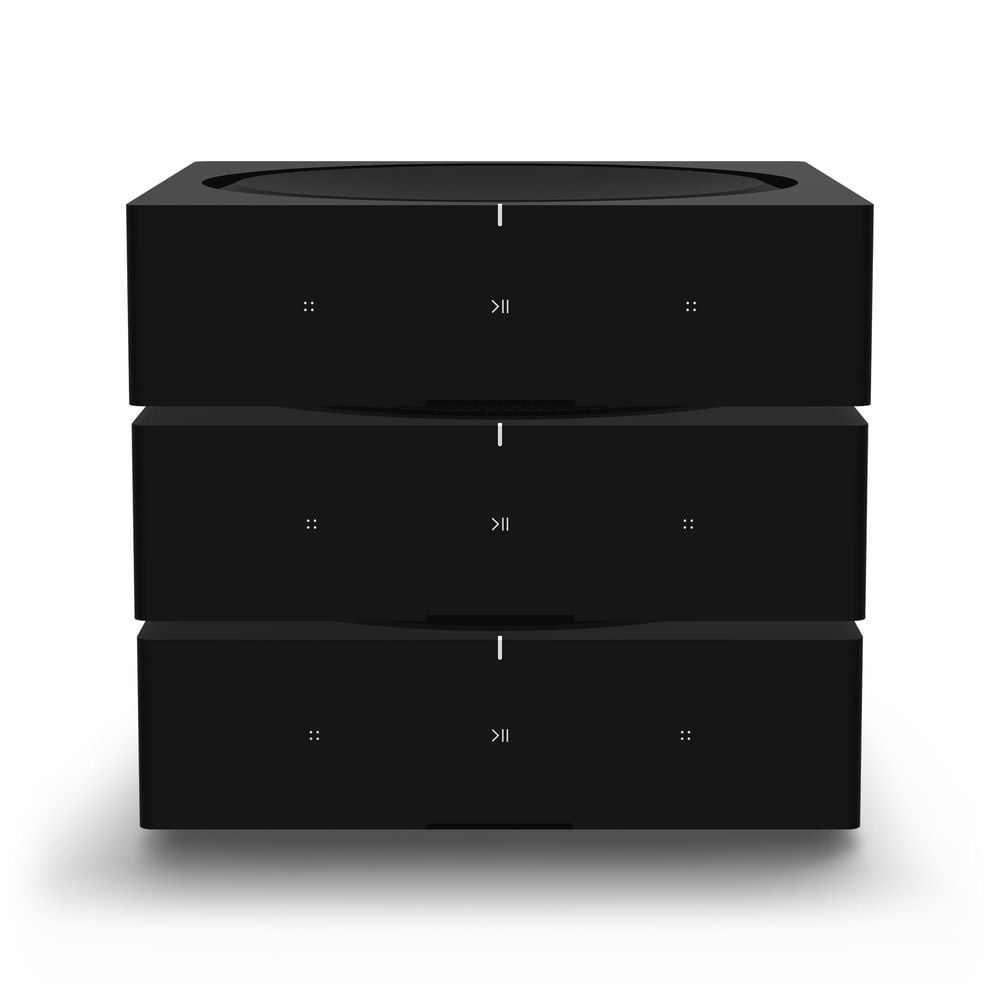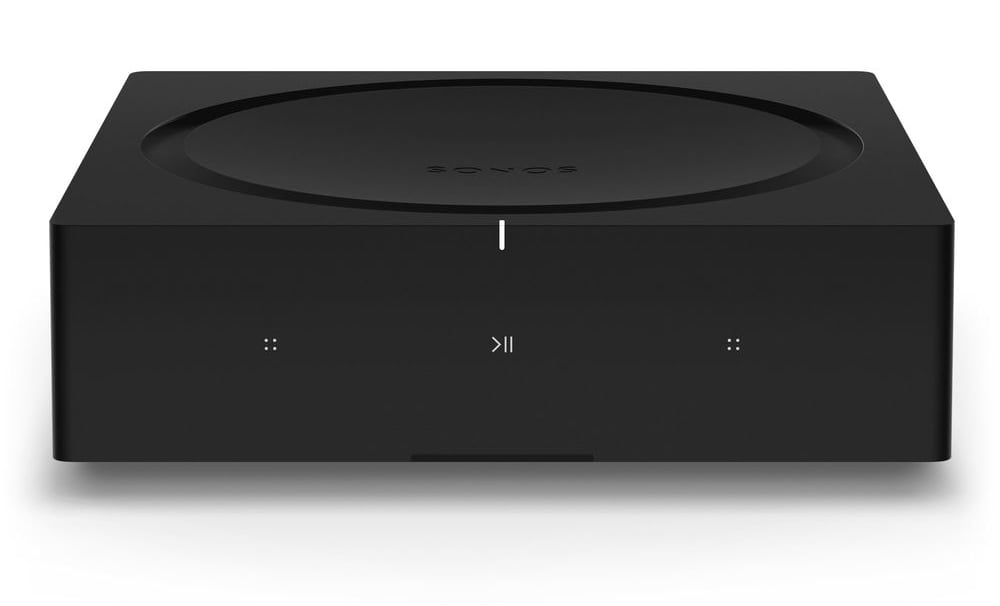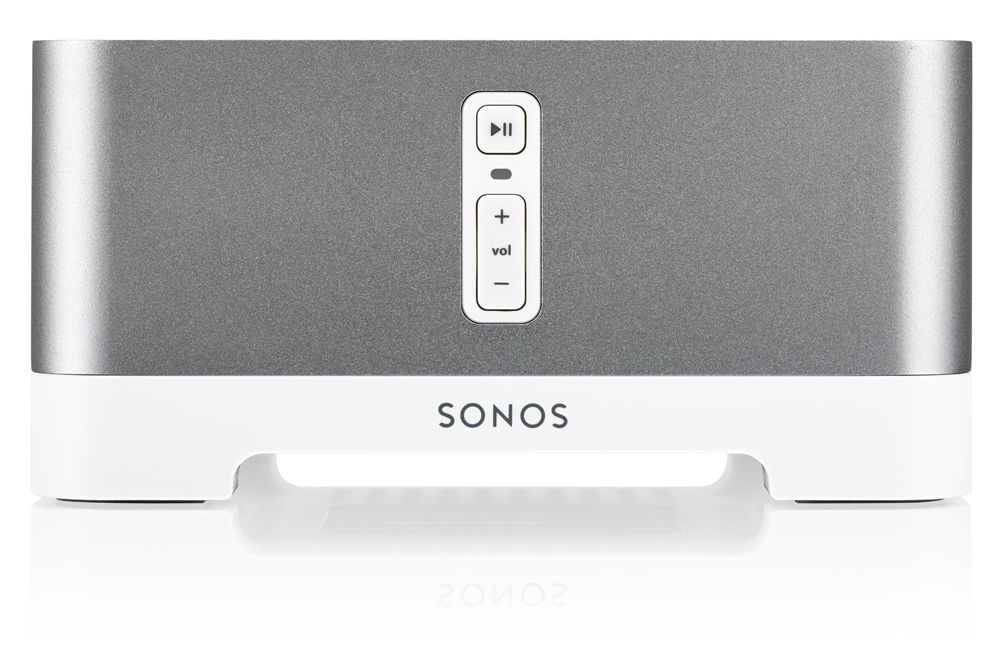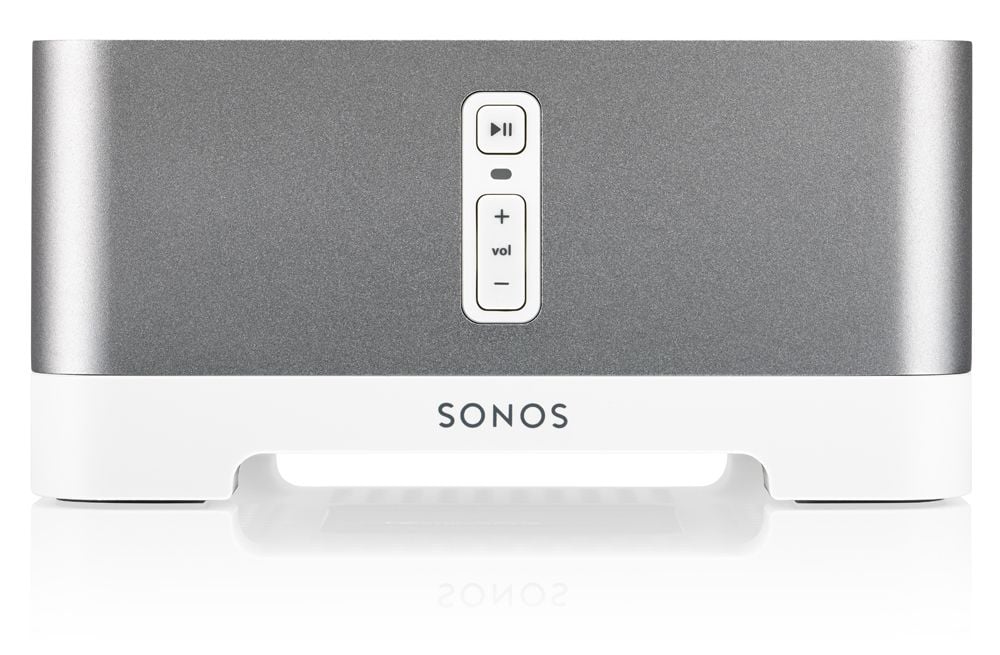SONOS
New Sonos Amp vs Connect:Amp
New and Improved Against a Classic
SONOS
New Sonos Amp
vs
Connect Amp
New and Improved Against a Classic
Sonos Amp vs Sonos Amp
In 2002, John MacFarlane, Tom Cullen, Trung Mai, and Craig Shelburne came up with a combined plan to help music lovers play any song anywhere in their homes. This concept seemed unachievable to most at the time, but later started one of the most popular wireless speaker companies in the world, Sonos.
In the early 2000s, the thought of a high-fidelity wireless music systems was less feasible because Wi-Fi wasn’t a home standard and other supporting technologies hadn’t come along yet. In 2004, Sonos brought their Digital Music system prototype to CES, where they won the “Best of Audio” award. A year later, Sonos released the ZP100 (ZP meaning Zone Player), replaced by the ZP120, and later rebranded as the Connect:Amp. The Sonos Connect:Amp is a digital music streamer and amplifier that powers passive speakers and connects to your Sonos digital ecosystem.
A decade later, Sonos has gained a massive fan base; ranging from music lovers with Play series speakers in every room, to custom installers and two channel enthusiasts, still swearing by the 10 year old Connect:Amp. Sonos has recently introduced a new product for the two channel lovers and custom install community. Today’s review is on this completely redesigned, more powerful and improved digital music streamer and amplifier, the Sonos Amp.

Packaging, Design & Build Quality
The Sonos Amp comes packaged in a heavy duty box and molded cardboard with “Sonos” embossed on the inside lid. Inside, the Amp is wrapped in a felt bag to protect the finish. Sonos products are typically very well packaged and are rarely damaged in shipping. After removing the protective felt covering, you can see the simplistic, yet well-crafted Sonos Amp.
The matte black square is a five pounds, 8.5” x 8.5” x 2.5” minimalistic design with three touch sensors on the face that give you the ability to control volume, play/pause, and previous/next track. The top is molded plastic with a vented circle air inlet along with a centralized heatsink, and a discrete output stage for releasing heat generated from operation. On the bottom, there is perforated plastic and another circle that fits perfectly with the shape on the top. Sonos made this design choice so that the Amps can be easily stacked and, when done so, heat will seamlessly travel through each one.
Another key design feature of the Sonos Amp is the use of banana plugs, which differ largely from the Connect:Amp’s spring loaded speaker connections. Included in the box are two sets of banana plug binding post terminals. These are simple screw-based plugs to connect your speaker wire. The binding posts are high quality and connect securely to ensure proper signal transfer.
Compared to the original Connect:Amp, the look and build of the new Sonos Amp is much more compact, simpler, and easier to stack and stash away. Overall, the device looks great if you enjoy a minimalistic design. It’s perfect for an entertainment center or stacked in an AV rack.
Features & Technology
The new Sonos amp is a 125-Watt x2, 8 ohms, class D amplifier that can power two or four passive speakers, depending on on the speaker specifications. The increased power is a big step up when put against the Connect:Amp. The Connect:Amp pushes 55-Watts vs the new Sonos amp that pushes 125-Watts.
At first glance, you’ll notice the inputs and outputs on the rear on the Sonos Amp. The Amp features:
- Analog RCA Input – To connect a turntable with a phono stage (built in or external), CD player, or any audio device with an RCA output.
- HDMI ARC – To connect a TV for audio without needing lower quality analog to digital conversion. You can also purchase a HDMI to optical digital adapter if you need/prefer to use optical digital.
- 2 Port Ethernet switch – To bypass WIFI for a dedicated Sonos network.
- Mono Sub-Out – To connect an external subwoofer.
- 2 Binding Post Terminals – To connect a set of passive speakers. At 125W you can also splice in an extra set to power four speakers without worrying about under powering the average speaker.

In addition to the wired inputs, the new Sonos amp features Wi-Fi streaming of Tidal, Spotify, Apple Music, Pandora, TuneIn, and more. You can use streaming services through the AirPlay 2 (if you use apple products or run iTunes) or through the free Sonos app.
Sonos takes as much pride in their software as they do their product, and that’s obvious while going through the setup process. Just like the other Sonos products, the entire setup is done on the app and is completed within a few minutes. After that, switching between HDMI, RCA, and streaming is as simple as changing the source in the app. Within this app, you can play your sources on the Amp or send it on any or every Sonos product in your home.
The new Sonos Amp also gives you some creativity with setups. Here’s some set up ideas for the Sonos Amp:
- Home Theater 4.1 (with Play series) – 2x passive front channel speaker, 2x Sonos Play:1 as rear channel, and a Sonos SUB (or wired subwoofer via mono sub out). Also Sonos’ technology features center channel simulation for clear dialogue.
- Home Theater 4.1 (Non-Sonos Speakers) – 2x passive front channel, 2x passive rear channel, wired subwoofer. Requires two Sonos Amps.
- In-Ceiling or Outdoor (2 or 4 speakers) – Install up to four passive in-ceiling or outdoor speakers.
- Two-channel Stereo – 2x passive speakers and a wired subwoofer or Sonos SUB (if you don’t have enough low-end)
The new Sonos Amp’s power and HDMI inputs give it the edge over the original Connect:Amp. Another feature that give Amp the advantage over its predecessor is new API’s and deeper integration for smart home control. While this can sound very technical, compatibility with third party programs (like IFTTT) make smart features very simple and fun to play with.
Adding:
- Line-in switching (for both analog and home theater) - allowing line-in components to be selected within the third-party control interface.
- Add Sonos playlists in third-party interface
- (In preview phase) Ability to provide notifications from third party devices - like a smart doorbell, through Sonos speakers.
Testing
Being one of the first to get our hands on the new Sonos Amp, we wanted to see what it was really capable of. We also wanted to make the “Sonos Amp vs Connect:Amp” a true test of performance and versatility. So, we laid out a few demos: two channel music, 4.1 home theater, and in-ceiling.
Two Channel
To start out our two channel test, we connected two floor-standing Bowers & Wilkins 703 S2 speakers (a fairly efficient speaker ). The Sonos Amp performed very well and played clearly at any volume, including high levels. When we tested the original Connect:Amp with the 703 S2s, it performed as well as we expected a 55W amplifier to perform; however it was unable to reach close to the volume levels of the new amp, and even at low levels, the clarity wasn’t as good as the new Sonos Amp.
We knew that the Bowers & Wilkins floor-standing speakers might be a little unfair for an even test, so we evened the playing field by connecting two Bowers & Wilkins 685 S2 bookshelf speakers (A very efficient speaker). When we connected the new Sonos Amp, the same clarity and fullness was shown with a wonderful and detailed soundstage. Then, we connected the Sonos Connect:Amp. The volume levels could be matched with these speakers, but there was an obvious difference in sound quality. Don’t get us wrong, even though the Connect:Amp couldn’t match the overall sound quality and fullness of the new amp, the Connect:Amp still isn’t a bad sounding product but the punchiness and clarity of the new Sonos Amp makes it a clear winner.
4.1 Home Theater
For the 4.1 home theater test, we only connected the new Sonos Amp because a single Connect:Amp wasn’t designed to easily play television compared to the new Sonos Amp’s HDMI input.
We connected the Bowers & Wilkins 703 S2 floor-standing speakers as our front channel, two Sonos Play One speakers as our rear channel, and the Sonos SUB as our subwoofer. Overall, this combination sounded surprisingly well. It put out enough sound to be immersive, and the simulated center channel made voices very clear. The HDMI ARC worked very well on the first try, and we were able to send our TV’s signal to other Sonos products we had around our facility.
If surround sound was the goal, a dedicated AV receiver would be more affordable in some cases but the the Sonos Amp’s versatility and simplicity gives it a huge advantage.
In-Ceiling
In-ceiling and outdoor speakers will likely be a predominant use for the new Sonos Amp as it has been with the Connect:Amp, so we wanted to see how the overall performance matched up.
We connected them to two GoldenEar MartinLogan Helos 22 in-ceiling speakers (very efficient speaker). Normally, a Connect:Amp powers these in our building and does a good job, and when we swapped it out for the new Sonos Amp, there was a huge difference. The overall volume range, bass, and clarity increased. The new Sonos Amp gave these speakers a backbone we haven’t heard; new punch and volume range, all while the clarity is very high.
A large advantage with the new Amp with the in-ceiling speakers is the ability to connect four in-ceiling speakers and the new smart home features, like notifications over your system. The Amp can power four in-ceiling speakers for one large or two small rooms, while the Connect:Amp can only push two.
Results
The build quality and power really stood out though all the testing, and not just in regards to sound. The new Sonos Amp could push through every test with low heat and great ventilation, showing that this product will not only perform well now, but also for years down the road. The comparison between Sonos Connect:Amp and Sonos Amp will automatically be skewed because of power, but the sound quality, features, and design on the new Sonos amp give it the overall upper hand.
Overall Recommendation
The Sonos Amp is a great addition to the Sonos product line and an overall powerful amplifier and streamer. If you’re a two-channel fan, custom installer, or want an impressive Sonos integrated system, this is for you. When placed against the Connect:Amp, you can see the much needed upgrades and quality improvement.
For its size and price, this amplifier and streamer is a powerful addition or start to a smart audio setup. This new Sonos Amp can be the center for a great sounding room or multiplied to power a whole home’s sound. Its versatility and sound quality are what we’ve come to expect from Sonos and we’re looking forward to seeing what features they add in the future to make this new Amp as iconic as the Connect:Amp.
If you would like to know how the new Sonos Amp can change your home’s sound, call or chat today.

Great Form Factor
The new Sonos Amp allows you to stack them up with great ventilation. Two fit side by side on most shelves as well.

Power and Punch
This small amp packs a ton of bass punch which makes it a perfect choice for where we think it will be used a lot, for in ceiling speakers.

Great Connectivity
Sonos added an HDMI in so the amp could be used in a 2.1 system, pretty cool!
Recommended Products:
-
 SONOS One Gen 2 Compact Wireless Speaker
Final Price $0.00
SONOS One Gen 2 Compact Wireless Speaker
Final Price $0.00




